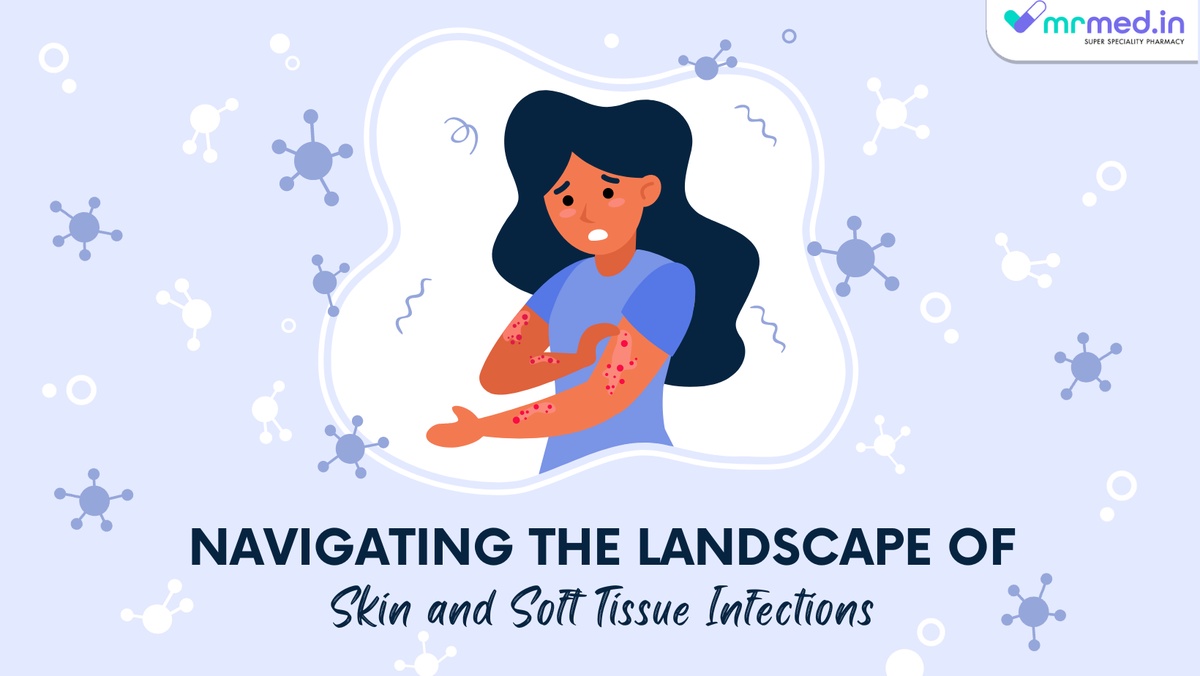Skin and soft tissue infections (SSTIs) are a range of problems that can affect your skin and the soft parts underneath. They can be as simple as a little red spot or as serious as necrotizing fasciitis, where the infection spreads deep into your body. These infections come in different forms, with different causes, and can vary in severity. It is like a big puzzle with many pieces to understand: types, causes, clinical manifestations, diagnosis, and treatment strategies. This article will help you understand all these parts in brief.
Types of SSTIs
- Cellulitis: It is a common bacterial infection affecting the deeper layers of the skin.
- Abscesses: Collection of pus within the skin or underlying tissues.
- Folliculitis: Infection of hair follicles.
- Impetigo: Highly contagious bacterial infection characterized by crusty sores.
- Necrotizing fasciitis: It is a severe, life-threatening, rapidly progressing infection of the deeper skin layers and subcutaneous tissues.
What Causes SSTIs
Most skin infections happen because of bacteria like Staphylococcus aureus (including the tough kind called MRSA) and Streptococcus pyogenes. Viruses like herpes and fungus like Candida can also be culprits in these diseases.
Risk Factors of SSTIs
Certain things can raise your chances of getting a skin infection. They usually fall into two groups: stuff about you (like if you're older or have health issues) and things that put you in contact with germs.
- Patient-related factors include being very sick, older age, having a weak immune system, and having problems with your liver, kidneys, or blood vessels. Also, if you have had certain leg or foot surgeries, you might be more likely to get an SSTI there.
- The other category includes injuries, certain activities, or being around certain animals that can expose you to specific bacteria. For example, having diabetes can increase the risk of getting an SSTI caused by Staphylococcus aureus or certain other bacteria. Similarly, being around certain animals or in certain environments, like hot tubs, can expose you to bacteria that can cause infections.
Clinical Presentation
Symptoms vary depending on the types and severity of the infection but commonly include redness, swelling, warmth, pain, and sometimes fever. The appearance of the lesion and associated symptoms can help differentiate between various SSTIs.
Diagnosis
- Clinical evaluation: Physical examination is done by your healthcare provider. This helps develop the provisional diagnosis of SSTIs, ruling out other infections.
- Laboratory tests: Culture and sensitivity testing of wound samples may be performed to identify the causative organism and determine antibiotic susceptibility.
- Imaging studies: In severe cases of SSTIs or when complications are suspected, imaging methods such as ultrasound or MRI are used to assess the extent of the infection.
Treatment
- Antibiotics: Empiric antibiotic therapy is often initiated based on the likely causative pathogens and local resistance patterns. MRSA coverage may be necessary, especially in areas with high MRSA prevalence. Augmentin 375mg tablet is commonly prescribed antibiotics for treating bacterial infections, including those affecting the skin and soft tissues. Augmentin contains two active ingredients: amoxicillin and clavulanic acid. Together, these components combat bacterial growth and help your body fight off the infection.
- Incision and drainage: For abscesses, surgical drainage is often required to evacuate pus and facilitate healing.
- Wound care: Proper wound care practices, including cleaning, debridement, and dressing, are essential for promoting healing and preventing complications.
- Adjuvant therapies: In cases with severe infections and those associated with systemic symptoms, adjunctive therapies like pain management and supportive care may be done.
Prevention
- Proper hygiene practices, like regular handwashing, can help prevent the spread of SSTIs.
- Prompt treatment of minor skin injuries and wounds can reduce the risk of infection.
In places with a higher chance of getting infections or in groups more likely to get sick, doctors might use a method called "decolonization" for people who carry a germ called MRSA. This helps stop them from getting infections again.
Complications and Outlook
Most skin and soft tissue infections (SSTIs) get better with treatment. But sometimes, they can get more serious. This might involve the infection spreading deep into the body, causing blood poisoning (sepsis) or a severe condition called necrotizing fasciitis. In these cases, doctors must act fast and use strong treatments to help you get better. Getting diagnosed and treated quickly is super important for avoiding these complications.
In Conclusion
Dealing with skin and soft tissue infections means understanding the different types of infections, what causes them, how they look and feel, how doctors figure out what's wrong, and what they can do to help you. Teamwork between doctors like skin experts, infection specialists, and surgeons is often needed, especially if the infection is severe or complicated.


No comments yet